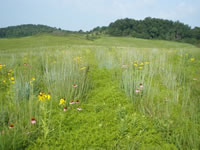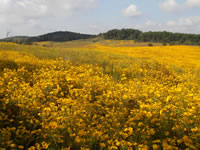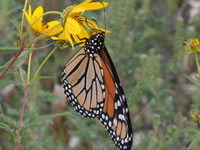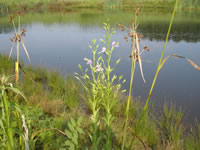Eastern Region Viewing Area
LOCATION and PHOTOS
 Summer (July) landscape of the Haskins Tract. Photo by Kirk W. Larson, Hoosier National Forest.
Summer (July) landscape of the Haskins Tract. Photo by Kirk W. Larson, Hoosier National Forest.
 Early fall (September) landscape of the Haskins Tract. Photo by Kirk W. Larson, Hoosier National Forest.
Early fall (September) landscape of the Haskins Tract. Photo by Kirk W. Larson, Hoosier National Forest.
 Monarch butterfly on showy tickseed (Bidens aristosa). Photo by Kirk W. Larson, Hoosier National Forest.
Monarch butterfly on showy tickseed (Bidens aristosa). Photo by Kirk W. Larson, Hoosier National Forest.
 Allegheny monkeyflower (Mimulus ringens) next to pond. Photo by Kirk W. Larson, Hoosier National Forest.
Allegheny monkeyflower (Mimulus ringens) next to pond. Photo by Kirk W. Larson, Hoosier National Forest.
Haskins Tract
Forest: Hoosier National Forest
District: Tell City Ranger District
Description: The Haskins Tract includes a large area of over 125 acres that the Hoosier National Forest maintains as an Early Successional Habitat and Native Pollinator Resource Area. Beginning in 2007, the Forest seeded the prior 100-acre row-crop field with a native seed mixture of 18 forbs and 6 grasses. The site contains two newly created ponds and the Forest planted the adjacent fields with several different native hardwood tree species. The area now provides an abundant variety of wildflowers that serve as an important source for pollinators such as native bees, moths, butterflies, and other insects. Visitors often observe wildlife such as turkeys, deer, bats, and many songbirds.
Wildflower Viewing Information: Because of the wide variety of plant species and habitat at the site, visitors can view differing displays of colorful wildflowers throughout the entire summer. Early summer plants most often seen include Allegheny monkeyflower (Mimulus ringens), bergamot (Monarda fistulosa), blackeyed Susan (Rudbeckia hirta), butterfly milkweed (Aslepias tuberosa), common milkweed (Aslepias syriaca), gray-headed coneflower (Ratibida pinnata), purple coneflower (Echinacea purpurea), rattlesnake master (Eryngium yuccifolium), spiked blazing star (Liatris spicata), and emerging clumps of warm season grasses. Later in the summer and by early fall the area is dominated by showy tickseed (Bidens aristosa) and partridge pea (Chamaecrista fasciculata), with scattered clumps of various species of goldenrod (Solidago spp.), native thistles (Cirsium spp.), and mistflower (Eupatorium spp.).
Safety First: Always carry a snack, insect repellant, water and a light raincoat, and wear (comfortable) hiking boots when hiking. If proceeding off the roadside, please use caution for unseen holes or dips in the terrain underneath the dense vegetation. Anticipate biting ticks and chiggers during June, July, and August. The county road leading to the Haskins Tract is often rutted and has loose gravel, so a high clearance vehicle is the best choice to travel to site.
Directions: From Interstate Highway I-64, go north on Indiana State Highway 37 from near the small town of Saint Croix, Indiana. Continue north on SR 37 about 1.5 miles to the Doolittle Mills Road and turn left heading west. Continue to the junction at Bethel Church. Take the road from the church continuing northwest about 1.3 miles to the Forest Service gate and parking area.
Ownership and Management: U.S. Forest Service, Hoosier National Forest, Tell City Ranger District. For more information, contact the Tell City Ranger District at (812) 547-7051 or the Forest Headquarters Office at (812) 275-5987.
Closest Towns: Saint Croix, Indiana and Birdseye, Indiana.

